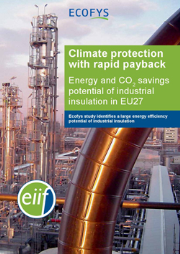 A new report titled, ‘Climate protection with rapid payback’ by Ecofys and EiiF, has identified the large energy and CO2 savings potential of industrial insulation.
A new report titled, ‘Climate protection with rapid payback’ by Ecofys and EiiF, has identified the large energy and CO2 savings potential of industrial insulation.
It also demonstrates that this potential is currently untapped despite being cost effective to implement. In fact, European industry is losing energy and money every day, emitting tonnes of avoidable CO2 emissions. “With just better maintenance and consistent insulating of industrial applications, about two thirds of the energy and emission saving potential could be tapped,” said Kornelis Blok, director of Science at Ecofys. “And since insulation investments will usually be paid back in less than one year, this is a great business opportunity.”
The EU Directive on Energy Efficiency aims at reducing the EU’s energy consumption by 20% by 2020. With current progress the EU will achieve only half of these savings. Any available technique that can contribute to reduce EU’s energy consumption is therefore needed more than ever.
Industrial insulation is one such technique. It can help European industry to reduce its total fuel consumption by 620PJ and emissions by 49 million tonnes of CO2. The report analyses that the saving potential exists across all regions, sectors, equipment and operating temperatures.
This total annual energy savings potential of 620PJ is equivalent to the energy consumption of 10 million households, and the annual CO2 reductions potential of 49Mt is equivalent to the CO2 emissions of 18 million cars.
However, why is the potential of industrial insulation in European industry so large? According to the study, ten percent or more of all equipment in industrial plants is not insulated or is covered with damaged insulation. Furthermore, the level of insulation applied is typically based on a minimum investment decisions. These decisions have been based on requirements regarding the maximum surface temperature. This to avoid personal injuries, minimum process needs or based on generic maximum heat loss rates. Requirements like cost effectiveness or maximum energy efficiency of the insulation system are often just not considered.
“In the past, when fuel prices were lower, energy efficient insulation would not have led to a large difference”, explained EiiF foundation director Andreas Gürtler. “But nowadays, besides the need to achieve the EU 20-20-20 goals, the price of energy is higher and is expected to grow even further. As a result we found an increasing gap between current and cost effective insulation levels.”
If industry takes the opportunity and starts to tap into the insulation potential this trend could be stopped. The first step would be to consequently insulate all non-insulated parts and to repair damaged insulation. If however, industry continues to ignore the large savings potential of industrial insulation, the gap between ‘current’ and cost effective insulation will further increase. Additional costs for CO2 emission allowances will even accelerate this trend.




